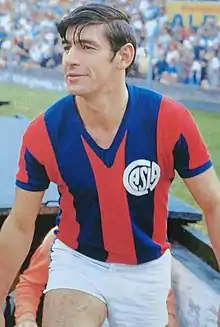San Lorenzo de Almagro
Club Atlético San Lorenzo de Almagro, commonly known as San Lorenzo de Almagro or simply San Lorenzo (in English: Saint Lawrence), is an Argentine sports club based in the Boedo district of Buenos Aires. It is best known for its football team, which plays in the Primera División, the first tier of the Argentine football league system. San Lorenzo is also considered one of the "big five" ("Los 5 Grandes") of Argentine football by Argentine press, with Independiente, River Plate, Boca Juniors, and Racing Club.
 | |||
| Full name | Club Atlético San Lorenzo de Almagro | ||
|---|---|---|---|
| Nickname(s) | Santo (Saint), Cuervo (Crow), Ciclón (Cyclone), Azulgrana (Blue and Red), Matadores (Killers), Gauchos de Boedo (Gauchos of Boedo) | ||
| Founded | 1 April 1908 | ||
| Ground | Estadio Pedro Bidegain, Flores, Buenos Aires | ||
| Capacity | 47,964 | ||
| Chairman | Marcelo Tinelli | ||
| Manager | Diego Dabove | ||
| League | Primera División | ||
| 2019–20 | 7th (aggregate table) | ||
| Website | Club website | ||
|
| |||
| Active departments of C.A. San Lorenzo de Almagro | ||||||||||||||||||||||||
|---|---|---|---|---|---|---|---|---|---|---|---|---|---|---|---|---|---|---|---|---|---|---|---|---|
|
San Lorenzo plays its home games at Estadio Pedro Bidegain, popularly known as Nuevo Gasómetro. The stadium and sports facilities are located in the Bajo Flores district of the Buenos Aires. The club's previous stadium was the Viejo Gasómetro, located in the Boedo district. In 1979, the Gasómetro was expropriated by the de facto Government of Argentina and then sold to supermarket chain Carrefour. The club currently has six headquarters: three in Boedo, one in Monserrat, one at Bajo Flores, and one in villa Gesell.[1] San Lorenzo also plans to expand its main seat on La Plata Avenue, while a 15-hectare campus in Ezeiza is projected to develop an olympic football program.
San Lorenzo's historical rival is Huracán, located in Parque Patricios. The two clubs play one of the older derbies in Argentina. Some supporters consider this derby as the third-most important after Superclásico and Clásico de Avellaneda, in addition to being one of the most uneven derbies of Argentine Football.
Other sports practised at the club are artistic roller skating, basketball, field hockey, futsal, handball, martial arts, roller hockey, swimming, tennis, and volleyball.[2] Some years ago, San Lorenzo had also opened a rugby union section,[3] but it is no longer active. San Lorenzo gained international recognition in March 2013 with the election of Pope Francis, a supporter of the club.[4][5] The players played with the Pope's photo on their shirts during a league match against Colón Santa Fe on 16 March 2013.[6]
History
Origins of the club
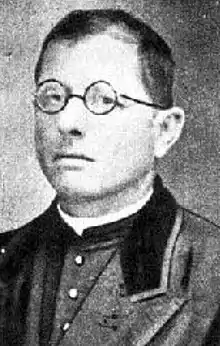
The roots of the institution can be found in a team formed by a group of kids that used to play football in the corner of México and Treinta y Tres Orientales streets of Buenos Aires. Due to increasing traffic in the city, playing football in the streets became a risky activity for the boys. Lorenzo Massa, the Catholic priest of the neighborhood's church, saw how a tram almost knocked down one of the boys while they were playing in the streets. As a way to prevent more accidents, he offered the boys to play in the church's backyard, under the condition they go to mass on Sundays.
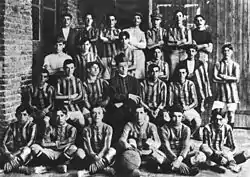
On 1 April 1908, an assembly was held in the Almagro district of Buenos Aires with the purpose of establishing a club. During the meeting, several names were proposed. The first option was "Los Forzosos de Almagro" ("The Strongmen of Almagro", the name used by the boys for their street football squad), which did not sound good to Father Massa (who was present). The other proposal was to name the club "San Lorenzo" as an homage to Massa, but he refused to be honored that way.
Nevertheless, the name was finally accepted by the priest, explaining that the name would not honor himself but both Lawrence of Rome ("San Lorenzo" in Spanish) and the Battle of San Lorenzo, one of the most significative combats for the Independence of Argentina. Another founding member, Federico Monti, suggested to add the name of the neighbourhood, Almagro where most of the members lived in, which was accepted by the assembly.
Due to the team not having its own a stadium, San Lorenzo began to play its home games in a field property of the Club Martínez, placed in the nearby town of the same name. The squad played its first match on 26 April 1914. At the end of the season, San Lorenzo had to play a final match against Excursionistas to declare a champion. San Lorenzo won the series (the results were 0–0 and 5–0). This title allowed San Lorenzo to enter the playoffs in for promotion to the Argentine Primera División, which was finally obtained after beating Club Honor y Patria by a score of 3–0.
First years in Primera

San Lorenzo began to play in the Argentine Football Association tournaments on 26 April 1914 in the second division, where the team finished sharing first place with Excursionistas. As a result, both teams played a two-match series to determine which team would proceed to the playoffs. San Lorenzo won the series after thrashing Excursionistas 5–0 in the second game.
In playoffs, San Lorenzo eliminated other teams before playing the final against Honor y Patria, winning 3–0 and being promoted to Primera División.[7]´
San Lorenzo made its debut in Primera on 4 April 1915, losing to Platense by 5–1. The first match won in the top division was the 7th fixture, when the team defeated Floresta by 3–1. San Lorenzo finished 12th at the end of the season, tied with Gimnasia y Esgrima de Buenos Aires.[8]
On 7 May 1916 the club inaugurated its first stadium (popularly known as "Viejo Gasómetro" during a match against Estudiantes de La Plata, which San Lorenzo won by 2–1. That same year, the team finished 7th in the Primera División championship. In subsequent tournaments the team did not wage good campaigns, finishing 12th[9] and 13th. In 1919 the Argentine league split into two leagues, the official Asociación Argentina and dissident Asociación Amateur (AAm),[10] in which San Lorenzo took part, along with Racing Club, River Plate and Independiente, among other teams. San Lorenzo finished 9th.
The success begins


In 1920 and 1922, San Lorenzo finished third, finally winning its first title in 1923. The squad won 17 of 20 games, only losing 2. San Lorenzo scored 34 goals in 20 fixtures, conceding 13.[11] That same year the squad also won its first international title, The Copa Campeonato del Río de la Plata after beating Montevideo Wanderers 1–0 in the final.
San Lorenzo won its second consecutive Primera División title one year later. The team played 23 matches winning 18 with 2 losses, with a total of 48 goals scored and 15 conceded.[12] In the following two seasons (1925 and 1926) San Lorenzo would make great performances finishing 2nd to Racing Club and Independiente respectively finally achieving its 3rd title in 1927, when both leagues AAF and AAm had joined again. The squad totaled 57 points in 33 matches played with an outstanding mark of 86 goals scored (2,60 per game) and conceding only 26.[13]

Apart of winning the domestic league, in 1927 San Lorenzo won its first and only Copa Aldao, after defeating Uruguayan team (Rampla Juniors) by 1–0. The club soon became one of the most popular institutions in Argentina, increasing its number of followers and being counted in the top five (cinco grandes) together with Boca Juniors, Independiente, River Plate and Racing Club.
In the 1930s, Isidro Lángara and other players of Basque descent endeared San Lorenzo to the Basque community. The team also relied on players from the provinces, known as los gauchos. San Lorenzo returned to success in 1933, when the team won its 4th league championship. The squad totaled 50 points with 22 wins, 6 losses and 6 draws. San Lorenzo scored 81 goals and conceded 48. Boca Juniors was the runner-up while Racing Club finished 3rd.
In 1936, there were two championships within the year, in a format of single-robin tournaments. San Lorenzo won the first round (named "Copa de Honor" for the occasion) while River Plate won the second round ("Copa Campeonato"). Although titles were recognised as official by the Association,[14][15][16][17] both champions, San Lorenzo and River Plate, had to play a match (named "Copa de Oro") in order to define which team would play the Copa Aldao match v. the Uruguayan Primera División champion. Finally, River Plate won the game by 4–2 and qualified to play Peñarol.
The 1940s: "The best team in the world"

In 1943, San Lorenzo won the national cup, the Copa General Pedro Ramírez, named in honor of Pedro Pablo Ramírez, the de facto president of Argentina by then. San Lorenzo won the trophy by defeating General Paz Juniors 8–3.
After the 1936 success, San Lorenzo would not win a league title for ten years, when in 1946 proclaimed champion with a total of 46 points (the runner-up, Boca Juniors, finished 2nd. with 42). San Lorenzo also scored a record of 90 goals in 30 games played, only conceding 37.
That same year (1946), the team went on to a tour of Spain and Portugal that was one of the highlights of the club's history. The team debuted playing Atlético Aviación winning 4–1. San Lorenzo played a total of 10 matches in Europe, with some extraordinary victories over the Spanish national team (7–5 and 6–1). The Spanish crowd at the stadium acclaimed San Lorenzo as "Son els millor del mon" ("You are the best in the world" in Catalan). San Lorenzo then moved to Portugal where the squad showed its skilled play, thrashing Porto (9–4) and the Portugal national team by 10–4. The only team that defeated San Lorenzo was Real Madrid by 4–1.
As a result of the successful tour, player René Pontoni was offered a contract with Barcelona, but declined to leave Argentina (Barcelona then drafted River Plate's Alfredo Di Stéfano). Fellow player Rinaldo Martino did stay in European football and would later become a star with Juventus.[18]
European tour details

| 1946–47 tour on Spain and Portugal[19] | ||
| Date | Rival | Result |
|---|---|---|
| 1946-12-23 | Atlético Aviación | 4–1 |
| 1946-12-25 | Real Madrid | 1–4 |
| 1947-01-01 | Spain national team | 7–5 |
| 1947-01-05 | Athletic de Bilbao | 3–3 |
| 1947-01-16 | Spain national team | 6–1 |
| 1947-01-22 | Valencia | 1–1 |
| 1947-01-26 | Dep. La Coruña | 0–0 |
| 1947-01-31 | Porto | 9–4 |
| 1947-02-02 | Portugal national team | 10–4 |
| 1947-01-26 | Sevilla | 5–5 |
The 1960s, 1970s, and 1980s
In the 1960s, a generation of players known as carasucias (literally: dirty faces) were the darling of Argentine fans because of their offensive, careless playing and their bad-boy antics off the pitch. The 1968 team was nicknamed los matadores as it won the championship without losing a single game. This team was recognized as the best team in the world by many journalists. In the years 1968–1974 San Lorenzo won four league titles, its best harvest ever. In 1972, the club became the first Argentine team to win two league titles in one year.
Poor administrations, however, led San Lorenzo to a huge economic crisis. Argentina's military government coerced the club into selling the historic stadium located in Boedo. The team was relegated in 1981, only to return to the top division with great fanfare in the 1982 season, which set all-time attendance records for the club.
The 1990s
By that time, the club had no stadium and was plagued by debt and irregularities. Controversial president Fernando Miele (1986–2001) delivered both the new stadium and two league titles: the Clausura '95 (after 21 years without winning a first division title) and the Clausura 2001 (in which the team achieved 11 consecutive victories). San Lorenzo finished the Clausura 2001 with 47 points in a tournament of 19 matches, setting the record for the highest points haul since the inception of the Apertura and Clausura system in 1990.
The New Millennium

In late 2001, San Lorenzo won their first international title: the Copa Mercosur 2001, becoming the only Argentine team to win that international cup, because the others champions were all from Brazil.
San Lorenzo also won the first edition of the Copa Sudamericana in December 2002, claiming their second international title, and getting the opportunity to play the Recopa against the Copa Libertadores champion Olimpia.
San Lorenzo is identified with the middle class atmosphere of the Boedo neighborhood. Its derby rival from the southern part of Buenos Aires are Huracán, who were promoted back to the first division for the 2007–08 season, only to be relegated again in 2011.
In 2007, San Lorenzo won the First Division League, Clausura 2007 beating Boca Juniors in the race for the title. Led by manager Ramón Díaz, San Lorenzo secured the title after the 17th round of fixtures, with two games still to play. They finished the tournament with 45 points.
Six years later, and only one year after being relegation-threatened, the club managed to win the Torneo Inicial 2013.
In 2014, San Lorenzo won their first Copa Libertadores.[20] In the final, they defeated Nacional of Paraguay 2–1 on aggregate, concluding their championship run with a 1–0 victory in the second leg at Estadio Pedro Bidegain. This earned the club a berth in the 2014 FIFA Club World Cup in Morocco, their first trip to FIFA's premier club tournament.[21] They would ultimately lose in the finals to Real Madrid, and finish as runners-up.
Stadium
.jpg.webp)

The Viejo Gasómetro stadium in what nowadays is known as Boedo was a venue of great renown, where many international games were held. During the military government in 1979 San Lorenzo was forced to sell the stadium for a small amount of money, and a few years later the supermarket chain Carrefour bought it. The price had mysteriously surged eightfold, but the Club did not get any extra money.
After 14 years of renting the stadium, San Lorenzo, with the help of fans, inaugurated the new stadium, Estadio Pedro Bidegain (nicknamed Nuevo Gasómetro), which opened in December 1993 at the intersection of the Perito Moreno and Varela avenues in the Flores neighborhood. The fans, however, never forgot the old stadium, and its former lot is claimed by San Lorenzo and its fans to this day. On 8 March 2012, there was a demonstration attended by over 100,000 people in favour of reclaiming the place for the club, and on 15 November the Buenos Aires City Legislature passed a bill stipulating that, in the course of six months, Carrefour should negotiate a deal with San Lorenzo in order to share the land lot, and if no accommodation was reached then the city would expropriate it with San Lorenzo's funds. First, an extension was agreed to and one-and-a-half years later, it signed an agreement establishing that the multinational retailer will build a smaller new store on a corner of its current property, financed by funds provided by San Lorenzo. The rest of the lot will be handed over to the club, and there are plans to build another new stadium there.
The current stadium has a capacity of 47,964 and the pitch size is 110 x 70 m, among the biggest in Argentina.
Nicknames
- Los Gauchos de Boedo (Boedo's Gauchos): In 1932, San Lorenzo brought players from different provinces from Argentina (principally from Santa Fe Province). Among them are, Alberto Chividini, Gabriel Magán y Genaro Cantelli.
- Los Santos (The Saints): The nickname emerged, because the club used The San Antonio's Oratory to make his activities from Soccer.
- Los Cuervos (The Crows): Was called so, because of the attire of the Cures (black)
- El Ciclón (The Cyclone): San Lorenzo's historical rival is Club Atlético Huracán, which means "hurricane". The nickname is adopted since cyclones are stronger than hurricanes.
- Los Azulgrana (The Blue and Red): The color of the club (Blue and Red).
- Los Matadores (The Killers), originally used for the unbeaten 1968 champions.
- The fans' collective calls itself La Gloriosa (The Glorious).
Players
Current squad
- As of 7 October 2020.[22]
Note: Flags indicate national team as defined under FIFA eligibility rules. Players may hold more than one non-FIFA nationality.
|
|
Players under contract
Note: Flags indicate national team as defined under FIFA eligibility rules. Players may hold more than one non-FIFA nationality.
|
Out on loan
Note: Flags indicate national team as defined under FIFA eligibility rules. Players may hold more than one non-FIFA nationality.
|
|
Most appearances
| No. | Player | Pos. | Tenure | Match. |
|---|---|---|---|---|
| 1 | DF | 1968–81 | 446 | |
| 2 | MF | 1962–75 | 415 | |
| 3 | MF | 1998–2004, 2009–18 | 383 | |
| 4 | MF | 1939–52 | 353 | |
| 5 | DF | 1919–34 |
Top scorers
| No. | Player | Pos. | Tenure | Goals |
|---|---|---|---|---|
| 1 | FW | 1953–1963, 1972 | 217 | |
| 2 | FW | 1925–40 | 169 | |
| 3 | FW | 1941–48 | 165 | |
| 4 | FW | 1965–72, 1977–78 | 143 | |
| 5 | RW | 1971–81 | 140 |
Notable former players
 Alfredo Carricaberry (1920–30)
Alfredo Carricaberry (1920–30) Luis Monti (1922–30)
Luis Monti (1922–30) Diego García (1925–40)
Diego García (1925–40)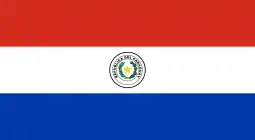 Clotardo Dendi (1931)
Clotardo Dendi (1931) Waldemar de Brito (1934–36)
Waldemar de Brito (1934–36) Alberto Zarzur (1935)
Alberto Zarzur (1935) Isidro Lángara (1939–43)
Isidro Lángara (1939–43) Ángel Zubieta (1939–52)
Ángel Zubieta (1939–52) Rinaldo Martino (1941–48)
Rinaldo Martino (1941–48) René Pontoni (1945–48), (1954)
René Pontoni (1945–48), (1954) José Sanfilippo (1953–62), (1972)
José Sanfilippo (1953–62), (1972) Ángel Berni (1953–59)
Ángel Berni (1953–59) Norberto Boggio (1957–62)
Norberto Boggio (1957–62) Raúl Páez (1958–67)
Raúl Páez (1958–67) Héctor Facundo (1959–63)
Héctor Facundo (1959–63) Oscar Rossi (1960–64)
Oscar Rossi (1960–64) Alberto Mariotti (1962–64)
Alberto Mariotti (1962–64) Narciso Doval (1962–68), (1979)
Narciso Doval (1962–68), (1979) Roberto Telch (1962–75)
Roberto Telch (1962–75) Rafael Albrecht (1963–70)
Rafael Albrecht (1963–70) Agustín Irusta (1963–76)
Agustín Irusta (1963–76) Héctor Veira (1963–69), (1973)
Héctor Veira (1963–69), (1973) Alberto Rendo (1965–69)
Alberto Rendo (1965–69) Rodolfo Fischer (1965–72), (1977–78)
Rodolfo Fischer (1965–72), (1977–78) Mario Chaldú (1966–67)
Mario Chaldú (1966–67) José Varacka (1966–67)
José Varacka (1966–67) Oscar Calics (1966–70)
Oscar Calics (1966–70) Antonio García Ameijenda (1967–74)
Antonio García Ameijenda (1967–74) Rubén Ayala (1968–73)
Rubén Ayala (1968–73) Antonio Rosl (1968–73)
Antonio Rosl (1968–73) Victorio Cocco (1968–74)
Victorio Cocco (1968–74) Rubén Glaria (1968–74)
Rubén Glaria (1968–74) Carlos Veglio (1968–75)
Carlos Veglio (1968–75) Rubén Glaria (1968–75)
Rubén Glaria (1968–75) Sergio Villar (1968–81)
Sergio Villar (1968–81) Enrique Chazarreta (1970–75)
Enrique Chazarreta (1970–75) Héctor Scotta (1971–75), (1979), (1981)
Héctor Scotta (1971–75), (1979), (1981) Oscar Ortiz (1971–76)
Oscar Ortiz (1971–76) Jorge Olguín (1971–79)
Jorge Olguín (1971–79) Ricardo Lavolpe (1975–79)
Ricardo Lavolpe (1975–79) José Luis Ceballos (1975), (1981)
José Luis Ceballos (1975), (1981) Claudio Marangoni (1976–79)
Claudio Marangoni (1976–79) Rubén Darío Insúa (1978–86)
Rubén Darío Insúa (1978–86) Walter Perazzo (1979–88)
Walter Perazzo (1979–88) Jorge Higuaín (1982–86)
Jorge Higuaín (1982–86) Jorge Rinaldi (1983–85), (1991–92)
Jorge Rinaldi (1983–85), (1991–92) Blas Giunta (1983–88)
Blas Giunta (1983–88) José Luis Chilavert (1985–88)
José Luis Chilavert (1985–88) Norberto Ortega Sánchez (1985–88), (1994–96)
Norberto Ortega Sánchez (1985–88), (1994–96) Néstor Gorosito (1988–89), (1992–93), (1996–99)
Néstor Gorosito (1988–89), (1992–93), (1996–99) Alberto Acosta (1988–90), (1992), (1998), (2001–03)
Alberto Acosta (1988–90), (1992), (1998), (2001–03) Leonardo Rodríguez (1990–91), (2001–02)
Leonardo Rodríguez (1990–91), (2001–02) Jorge Borelli (1992–96)
Jorge Borelli (1992–96) Oscar Passet (1992–99)
Oscar Passet (1992–99)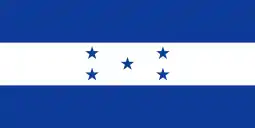 Eduardo Bennet (1993–95)
Eduardo Bennet (1993–95) Paulo Silas (1993–97)
Paulo Silas (1993–97) Esteban González (1994–95)
Esteban González (1994–95) Oscar Ruggeri (1994–97)
Oscar Ruggeri (1994–97)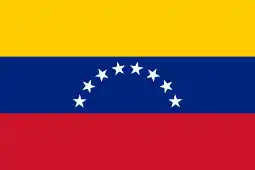 Gilberto Angelucci (1994–98)
Gilberto Angelucci (1994–98) Fernando Galetto (1994–99)
Fernando Galetto (1994–99) Claudio Biaggio (1994–99)
Claudio Biaggio (1994–99) Sebastián Abreu (1996–97), (2000–01)
Sebastián Abreu (1996–97), (2000–01) Guillermo Franco (1996–02)
Guillermo Franco (1996–02) Iván Córdoba (1998–00)
Iván Córdoba (1998–00) Walter Erviti (1998–02)
Walter Erviti (1998–02) Claudio Morel Rodríguez (1998–04)
Claudio Morel Rodríguez (1998–04) Bernardo Romeo (1998–01), (2007–10), (2012)
Bernardo Romeo (1998–01), (2007–10), (2012) Leandro Romagnoli (1999–05), (2009–18)
Leandro Romagnoli (1999–05), (2009–18) Sebastián Saja (2000–03), (2005–06)
Sebastián Saja (2000–03), (2005–06) Fabricio Coloccini (2000–01), (2016–present)
Fabricio Coloccini (2000–01), (2016–present) Agustín Orion (2001–09)
Agustín Orion (2001–09) Gonzalo Rodríguez (2002–04), (2017–20)
Gonzalo Rodríguez (2002–04), (2017–20) Pablo Zabaleta (2002–05)
Pablo Zabaleta (2002–05) Pablo Barrientos (2003–06), (2008–09), (2014–16)
Pablo Barrientos (2003–06), (2008–09), (2014–16) Ezequiel Lavezzi (2004–07)
Ezequiel Lavezzi (2004–07) Paolo Montero (2005–06)
Paolo Montero (2005–06) José Cardozo (2005–06)
José Cardozo (2005–06) Claudio Husaín (2006)
Claudio Husaín (2006) Andrés D'Alessandro (2008)
Andrés D'Alessandro (2008) Diego Placente (2008), (2010–11)
Diego Placente (2008), (2010–11) Gonzalo Bergessio (2008–09), (2016–17)
Gonzalo Bergessio (2008–09), (2016–17) Néstor Ortigoza (2011–12), (2013–17)
Néstor Ortigoza (2011–12), (2013–17) Carlos Bueno (2012)
Carlos Bueno (2012) Julio Buffarini (2012–16)
Julio Buffarini (2012–16) Juan Mercier (2012–18)
Juan Mercier (2012–18) Ignacio Piatti (2012–14), (2020–present)
Ignacio Piatti (2012–14), (2020–present) Ángel Correa (2013–14)
Ángel Correa (2013–14) Emmanuel Más (2013–16)
Emmanuel Más (2013–16) Sebastian Torrico (2013–present)
Sebastian Torrico (2013–present) Mario Yepes (2014–15)
Mario Yepes (2014–15) Fernando Belluschi (2016–20)
Fernando Belluschi (2016–20) Paulo Díaz (2016–18)
Paulo Díaz (2016–18) Tino Costa (2016–17)
Tino Costa (2016–17)
Managers
|
|
|
|
Records
- The first Argentine soccer club to win two league titles in the same year, picking up the Metropolitano and Nacional championships in 1972.
- The first undefeated champion in 1968 Primera División.
- The first club to win the Copa Sudamericana.
- The only Argentine club to win the Copa Mercosur.
- The first Argentine club to participate in the Copa Libertadores in 1960
- San Lorenzo is also considered as one of the FIFA Classic Clubs.
- The first champion of a Unified Championship, in 1927.
- The first club who was undefeated champion two times in history: 1968 and 1972.
Honours
League
- Primera División (15): 1923 AAm,[lower-alpha 1] 1924 AAm,[lower-alpha 1] 1927, 1933 LAF,[lower-alpha 2] 1936 (Copa de Honor)[lower-alpha 3][25] 1946, 1959, 1968 Metropolitano,
1972 Metropolitano, 1972 Nacional, 1974 Nacional, 1995 Clausura, 2001 Clausura, 2007 Clausura, 2013 Inicial - Primera División B (2): 1914,[lower-alpha 4] 1982[27]
National cups
- Copa de la República (1): 1943[28]
- Supercopa Argentina (1): 2015
Unofficial cups
Not recognized as official titles by the Argentine Football Association.[29][30]
- Copa San Martín de Tours [lower-alpha 5] (1): 1994[31]
- Copa Jorge Newbery (1): 1964[32]
International
- Copa Libertadores (1): 2014[33] [note 1]
- Copa Mercosur (1): 2001 [note 1]
- Copa Sudamericana (1): 2002 [note 1]
- Copa Aldao (1): 1927 [note 2]
- Copa Campeonato del Río de la Plata [lower-alpha 6] (1): 1923[34] [note 2]
- Notes
- Conmebol competition
- Organised by AFA and AUF together
Women
The women's team has won the national championship, Campeonato de Fútbol Femenino in 2008/09 and 2015.[35] They finished fourth of five in the group stage of the 2009 Copa Libertadores Femenina.
Basketball
San Lorenzo has played basketball since 1930 when the club affiliated to the association. On 26 April 1985, San Lorenzo played the opening game of the recently created Liga Nacional de Básquetbol (LNB), facing Argentino de Firmat at Obras Sanitarias venue.[36]
The team returned to LNB in 2015.
Notes
- The Asociación Amateurs de Football (AAmF) was a rival association which organized its own championships from 1919 to 1926.
- The Liga Argentina de Football was a dissident professional league that organised its own championships from 1931 to 1934, then merging with the official Association.
- In July 2013, The Argentine Football Association recognized the 1936 Copa de Honor won by San Lorenzo as a Primera División honour. The information was also added to AFA's website.[23][24]
- In 1914, the Primera B (named "Segunda División" by then) was actually the third level of Argentine football league system after División Intermedia, established in 1911.[26]
- The matches of this Cup belonged to the league or National championship. From 1986 to 1996 it was played in the most important match between two Buenos Aireans teams.
- The Copa Campeonato del Río de la Plata was an official football competition organized by the Amateur Football Association and the Uruguayan Football Federation. It was played with a similar format to the Copa Aldao, but in this case, involving the champions of the dissident associations.
References
- "La historia de Atlético-San Lorenzo, el clásico de nuestra ciudad". Pulso Geselino. Retrieved 22 October 2020.
- Deportes on San Lorenzo official website
- "San Lorenzo rugby, cierre de un gran año", Argentine Webb Ellis website, 7 December 2009
- Pope Francis divides opinion in Argentina by Vladimir Hernandez
- Pope Francis: the quiet man of Buenos Aires known for his humble tastes The Guardian, 13 March 2013
- Murphy Dohn, Patti (9 July 2014). "Argentina's good luck charm: What you should know about Pope Francis' love of soccer and the World Cup". The Catholic Review. Archived from the original on 16 July 2014. Retrieved 30 August 2014.
- Museo de San Lorenzo – Ascenso 1914
- Argentina 1915 at RSSSF
- Argentina 1917 at RSSSF
- Historia del Fútbol Amateur en la Argentina, by Jorge Iwanczuk. Published by Autores Editores (1992) – ISBN 9504343848
- Argentina 1923 at RSSSF
- Argentina 1924 at RSSSF
- Argentina 1927 at RSSSF
- Memoria y Balance General 1936, p. 24 – Argentine Football Association Library
- "Campeones de Primera División" on AFA website
- "¿River y San Lorenzo campeones... de 1936?" on Goal.com, 5 July 2013
- "La AFA le dio un campeonato a River y a San Lorenzo y se desató la polémica" on CanchaLlena.com, 5 July 2013
- "Cuando San Lorenzo fue el mejor del mundo", Clarín, 26 September 2012
- "La historia oficial" on Museo de San Lorenzo website
- "San Lorenzo seize the holy grail". FIFA.com. 15 August 2014. Retrieved 16 October 2014.
- "Crucial penalty gives San Lorenzo first Libertadores Cup". Reuters. 13 August 2014. Retrieved 20 August 2014.
- "San Lorenzo squad". Soccerway. Retrieved 22 March 2020.
- "La AFA les reconoció otro título a San Lorenzo y a River", Clarín, 6 July 2013
- "77 años después: San Lorenzo y River, campeones!", Crónica, 5 July 2013 Archived 16 December 2013 at the Wayback Machine
- "Memoria y Balance 1936", p.41 – AFA Library
- Campeones Argentinos – CIHF
- Segunda División – Campeones on AFA website
- Campeonato de la República at RSSSF
- Campeones de la Primera División (era amateur 1891–1934) at AFA website
- Campeones de la Primera División (era profesional: desde 1931) at AFA website
- Copa San Martín de Tours: historic results at RSSSF
- Copa Jorge Newbery 1964, Museo de San Lorenzo website
- "San Lorenzo win Copa Libertadores". ESPN FC. 14 August 2014. Retrieved 14 August 2014.
- Campeonato Rioplatense on RSSSF
- "Con perfume de mujer: San Lorenzo es campeón de AFA" (in Spanish). diariouno.com.ar. 26 September 2015. Retrieved 27 September 2015.
- "Hace 30 años nacía la Liga Nacional de Básquetbol en Argentina", Telam, 26 April 2015
